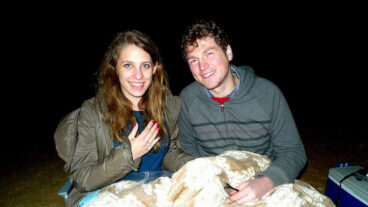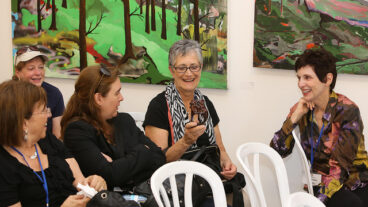Activists told focus on Israel beyond the conflict
Thursday, July 26, 2007
by Eric Fingerhut
Staff Writer
The women dress in burkas and are subservient to men. There’s no grass or green anywhere, but lots of barbed wire. Everyone is ultrareligious.
That’s the image many Americans have of Israel, according to focus group research. And Larry Weinberg wants to change that.
“Israel is defined by two lenses – the eternal conflict or [religious] Orthodoxy,” he told about 30 local Jewish activists on Wednesday of last week at the Embassy of Israel in the District. “We need another lens,” a “human” one that focuses on technology, health and culture, he said.
Americans, he added, need to know that Israel is helping to make their lives “easier, safer, more efficient and healthier,” he said.
Weinberg is executive vice president of Israel21c, a Los Angeles-based nonprofit organization whose aim is to provide Americans with news and information about Israel “beyond the conflict.” He was in town last week to offer what he calls a “new paradigm” for pro-Israel communications at an “Israel Branding Summit” for invited guests, both in the morning at the embassy and later that evening at the Jewish Community Center of Greater Washington in Rockville.
Similar events have been held eight times in various American cities during the past year, including San Francisco, Miami and Boston.
Israel21c uses research from focus groups that had been convened by the Brand Israel Group, marketing professionals concerned about Israel’s image, according to Weinberg.
He said that Israel is a “ubiquitous positive presence in the lives of all Americans.” As evidence, he pointed out that Israeli-made computer chips and other technological advances help power such everyday products as cellphones, satellite television and MRI machines.
“Why don’t people know this stuff?” he asked. “We haven’t been telling them about it.”
Weinberg said the recent controversial photo spread of female Israel Defense Forces soldiers in sexy poses in the men’s magazine Maxim was a “superb” example of strategic communications, because it exposed millions of young American males – a demographic that knows the “least information about Israel” – to the Jewish state and “gets them to think differently” about the country.
“Pro-Israel communication should be like a well-balanced meal,” Weinberg said. News about Israeli technology and culture “is not dessert, not something you do when you have room,” he said. “It may not be the steak, but it’s got to be the peas and mashed potatoes that come with it.”
One attendee cautioned that altering public opinion on Israel will not be easy.
Norman Goldstein, vice president of Israel and overseas for the Jewish Federation of Greater Washington, said he strongly favors the idea, but noted that “there is a presupposition that everybody really cares” intensely about Israel.
While everyone in the room last week did so, it’s not something regularly on the minds of many others, he said.
Getting Israel to turn up on their radar screen, he said, is a “real challenge.”
Weinberg and Israel21c consultant Pearl Lerner Kane, who also spoke to the group, acknowledge that news about Israeli medical discoveries or the hip-hop scene in the Jewish state are never going to overtake news about the conflict, and they emphasize that they are not advising anyone to ignore that aspect of Israel.
Their effort also does not replace the continued need for political advocacy, they said. But over the long term, they envision that news reporting about Israel could go from the current 98 percent about the conflict to perhaps 70 percent, with the remaining 30 percent beyond the conflict.
Kane said the best way to get that message out is through “word of mouth,” whether by talking about the topic in one’s social networks or alerting media contacts about stories that they might find interesting.
For instance, Weinberg recalled to the gathering a recent dinner he and his wife had with a couple he was meeting for the first time. Aware that the husband was an endocrinologist, he spent a half-hour earlier that day researching information about Israel in which the doctor might be interested.
The Israel21c effort comes as recent polls show American support for Israel in its conflict with the Palestinians is as strong as ever. Weinberg said after the summit that such support is important, but is “all based on Israel’s geopolitical utility to the United States,” and that Americans need to be given additional reasons why they should identify with the Jewish state.
Reaction from those in attendance last week was enthusiastic.
Miriam Zaghi, who teaches about modern-day Israel at the Melvin J. Berman Hebrew Academy in Rockville, said she thought the idea was great.
“It’s a nice shift,” said Zaghi, 30. “People need a positive vision.”
She added that “word of mouth works,” noting that she’s seen it work when she’s “gone out and spoken to people.”
“Word of mouth is more than one to one,” said Leonard Bebchick, an American Jewish Committee Washington-area vice president. He noted that having other Jewish organizations link to Israel21c’s Web site, for instance, will help get the message out. (The organization also sends out a weekly e-newsletter with links to the new stories that have been posted to its Web site, and Weinberg said the group has already placed 5,000 stories in American media during the past few years.)
Eric Rozenman, Washington director of CAMERA (Committee for Accuracy in Middle East Reporting in America), also thought Israel21c’s ideas are important, noting that when he meets with media members, he will suggest that reporters write about other aspects of the Jewish state besides the conflict.
While emphasizing the continued need for media watchdog groups like his, he said grassroots efforts like Israel21c’s could be effective in the long term. As an example, he pointed to the success of Arab propaganda efforts since the Six Day War, which he said helped turn once positive media chronicling of the Jewish state into much more critical coverage in recent years.











